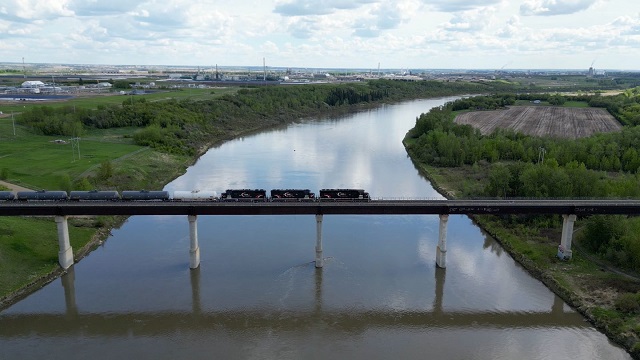Alberta
Alberta rail hub doubling in size to transport plastic from major new carbon-neutral plant

Haulage bridge at Cando Rail & Terminals’ Sturgeon Terminal in Alberta’s Industrial Heartland, near Edmonton. Photo courtesy Cando Rail & Terminals
From the Canadian Energy Centre
By Will Gibson
Cando Rail & Terminals to invest $200 million to support Dow’s Path2Zero petrochemical complex
A major rail hub in Alberta’s Industrial Heartland will double in size to support a new carbon-neutral plastic production facility, turning the terminal into the largest of its kind in the country.
Cando Rail & Terminals will invest $200 million at its Sturgeon Terminal after securing Dow Chemical as an anchor tenant for its expanded terminal, which will support the planned $8.9 billion Path2Zero petrochemical complex being built in the region northeast of Edmonton.
“Half of the terminal expansion will be dedicated to the Dow project and handle the products produced at the Path2Zero complex,” says Steve Bromley, Cando’s chief commercial officer.
By incorporating carbon capture and storage, the complex, which began construction this spring, is expected to be the world’s first to produce polyethylene with net zero scope 1 and 2 emissions.
The widely used plastic’s journey to global markets will begin by rail.
“Dow stores their polyethylene in covered railcars while waiting to sell it,” Bromley says.
“When buyers purchase it, we will build unit trains and those cars will go to the Port of Prince Rupert and eventually be shipped to their customers in Asia.”
A “unit train” is a single train where all the cars carry the same commodity to the same destination.
The expanded Cando terminal will have the capacity to prepare 12,000-foot unit trains – or trains that are more than three-and-a-half kilometers long.
Construction will start on the expansion in 2025 at a 320-acre site west of Cando’s existing terminal, which 20 industrial customers use to stage and store railcars as well as assemble unit trains.
Bromley, a former CP Rail executive who joined Cando in 2013, says the other half of the terminal’s capacity not used by the Dow facility will be sold to other major projects in the region.
The announcement is the latest in a series of investments for Cando to grow its operations in Alberta that will see the company spend more than $500 million by 2027.
The company, which is majority owned by the Alberta Investment Management Corporation previously spent $100 million to acquire a 1,700-railcar facility in Lethbridge along with $150 million to build its existing Sturgeon terminal.
Cando Rail’s existing Sturgeon Terminal near Edmonton, Alberta. Photo courtesy Cando Rail & Terminals
“Alberta is important to us – we have 300 active employees in this province and handle 900,000 railcars annually here,” Bromley says.
“But we are looking for opportunities across North America, both in Canada and the United States as well.”
Cando released the news of the Sturgeon Terminal expansion at the Alberta Industrial Heartland Association’s annual conference on Sept. 19.
“This is an investment in critical infrastructure that underpins additional growth in the region,” says Mark Plamondon, the association’s executive director.
The announcement came as the association marked its 25th anniversary at the event, which Plamondon saw as fitting.
“Dow’s Path2Zero came to the region because of the competitive advantages gained by clustering heavy industry. Competitive advantages are built from infrastructure that’s already here, such as the Alberta Carbon Trunk Line, which transports and stores carbon dioxide for industry,” he says.
“Having that level of integration can turn inputs into one operation into outputs for another. Competitive advantages for one become advantages for others. Cando’s investment will attract others just as Dow’s Path2Zero was a pull for additional investment.”
Alberta
Medical regulator stops short of revoking license of Alberta doctor skeptic of COVID vaccine

From LifeSiteNews
The Democracy Fund has announced that COVID-skeptic Dr. Roger Hodkinson will retain his medical license after a successful appeal against allegations of ‘unprofessional conduct’ by the College of Physicians and Surgeons of Alberta.
A doctor who called for officials to be jailed for being complicit in the “big kill” caused by COVID measures will get to keep his medical license thanks to a ruling by a Canadian medical regulator.
The Democracy Fund (TDF) announced in an April 4 press release that one of its clients, Dr. Roger Hodkinson, will retain his medical license after filing an appeal with the College of Physicians and Surgeons of Alberta (CPSA) over allegations of “unprofessional conduct regarding 17 public statements made in November 2020 and April 2021.”
Hodkinson had routinely argued against the dictates of public health and elected officials and “presented an alternative perspective on COVID-19, including the efficacy of masking and vaccines,” TDF noted.
In 2021, Hodkinson and Dr. Dennis Modry publicly blasted the then-provincial government of Alberta under Premier Jason Kenney for “intimidating” people “into compliance” with COVID-19 lockdowns.
In 2022, Hodkinson said that leaders in Canada and throughout the world have perpetrated the “biggest kill ever in medicine’s history” by coercing people into taking the experimental COVID injections and subjecting them to lengthy lockdowns.
These statements, among others, led the CPSA to claim that Hodkinson had promoted inaccurate or misleading information. “However, following negotiations with lawyers for The Democracy Fund, the CPSA limited its claims to arguing that Dr. Hodkinson’s comments violated the ethical code and extended beyond the scope of a general pathologist.”
Thus, Hodkinson did not “concede that any of his statements were false,” but “acknowledged that his criticisms of other physicians technically breached the Code of Ethics and Professionalism,” the group explained. “He also admitted that he should have clarified that his views were outside the scope of a general pathologist.”
Instead of having his license revoked, TDF stated that Dr. Hodkinson received a “caution” and will have to “complete an online course on influence and advocacy.”
“However, he did not concede that any of his statements were misinformation, nor did the tribunal make such a determination,” noted lawyer Alan Honner.
While Hodkinson received a slap on the wrist, a number of Canadian doctors have faced much harsher sanctions for warning about the experimental vaccines or other COVID protocols such as lockdowns, including the revocation of their medical licenses, as was the case with Dr. Mark Trozzi and others.
Some of Hodkinson’s warnings seem to have been vindicated by the current Alberta government under Premier Danielle Smith, who commissioned Dr. Gary Davidson to investigate the previous administration’s handling of COVID-19.
Davidson’s report, which was made public earlier this year, recommended the immediately halt of the experimental jabs for healthy children and teenagers, citing the risks the shots pose.
Alberta
Province introducing “Patient-Focused Funding Model” to fund acute care in Alberta

Alberta’s government is introducing a new acute care funding model, increasing the accountability, efficiency and volume of high-quality surgical delivery.
Currently, the health care system is primarily funded by a single grant made to Alberta Health Services to deliver health care across the province. This grant has grown by $3.4 billion since 2018-19, and although Alberta performed about 20,000 more surgeries this past year than at that time, this is not good enough. Albertans deserve surgical wait times that don’t just marginally improve but meet the medically recommended wait times for every single patient.
With Acute Care Alberta now fully operational, Alberta’s government is implementing reforms to acute care funding through a patient-focused funding (PFF) model, also known as activity-based funding, which pays hospitals based on the services they provide.
“The current global budgeting model has no incentives to increase volume, no accountability and no cost predictability for taxpayers. By switching to an activity-based funding model, our health care system will have built-in incentives to increase volume with high quality, cost predictability for taxpayers and accountability for all providers. This approach will increase transparency, lower wait times and attract more surgeons – helping deliver better health care for all Albertans, when and where they need it.”
Activity-based funding is based on the number and type of patients treated and the complexity of their care, incentivizing efficiency and ensuring that funding is tied to the actual care provided to patients. This funding model improves transparency, ensuring care is delivered at the right time and place as multiple organizations begin providing health services across the province.
“Exploring innovative ways to allocate funding within our health care system will ensure that Albertans receive the care they need, when they need it most. I am excited to see how this new approach will enhance the delivery of health care in Alberta.”
Patient-focused, or activity-based, funding has been successfully implemented in Australia and many European nations, including Sweden and Norway, to address wait times and access to health care services, and is currently used in both British Columbia and Ontario in various ways.
“It is clear that we need a new approach to manage the costs of delivering health care while ensuring Albertans receive the care they expect and deserve. Patient-focused funding will bring greater accountability to how health care dollars are being spent while also providing an incentive for quality care.”
This transition is part of Acute Care Alberta’s mandate to oversee and arrange for the delivery of acute care services such as surgeries, a role that was historically performed by AHS. With Alberta’s government funding more surgeries than ever, setting a record with 304,595 surgeries completed in 2023-24 and with 310,000 surgeries expected to have been completed in 2024-25, it is crucial that funding models evolve to keep pace with the growing demand and complexity of services.
“With AHS transitioning to a hospital-based services provider, it’s time we are bold and begin to explore how to make our health care system more efficient and manage the cost of care on a per patient basis. The transition to a PFF model will align funding with patient care needs, based on actual service demand and patient needs, reflecting the communities they serve.”
“Covenant Health welcomes a patient-focused approach to acute care funding that drives efficiency, accountability and performance while delivering the highest quality of care and services for all Albertans. As a trusted acute care provider, this model better aligns funding with outcomes and supports our unwavering commitment to patients.”
“Patient-focused hospital financing ties funding to activity. Hospitals are paid for the services they deliver. Efficiency may improve and surgical wait times may decrease. Further, hospital managers may be more accountable towards hospital spending patterns. These features ensure that patients receive quality care of the highest value.”
Leadership at Alberta Health and Acute Care Alberta will review relevant research and the experience of other jurisdictions, engage stakeholders and define and customize patient-focused funding in the Alberta context. This working group will also identify and run a pilot to determine where and how this approach can best be applied and implemented this fiscal year.
Final recommendations will be provided to the minister of health later this year, with implementation of patient-focused funding for select procedures across the system in 2026.
-

 2025 Federal Election1 day ago
2025 Federal Election1 day agoLiberals Replace Candidate Embroiled in Election Interference Scandal with Board Member of School Flagged in Canada’s Election Interference Inquiry
-

 espionage2 days ago
espionage2 days agoU.S. Experts Warn Canada Is Losing the Fight Against PRC Criminal Networks—Washington Has Run Out of Patience
-

 Automotive2 days ago
Automotive2 days agoTesla Vandals Keep Running Into The Same Problem … Cameras
-

 Business8 hours ago
Business8 hours agoTrump threatens additional 50% tariffs on China, urges ‘patience’
-

 Alberta7 hours ago
Alberta7 hours agoProvince introducing “Patient-Focused Funding Model” to fund acute care in Alberta
-

 Business21 hours ago
Business21 hours agoJury verdict against oil industry worries critics, could drive up energy costs
-

 Alberta1 day ago
Alberta1 day agoIs Canada’s Federation Fair?
-

 MacDonald Laurier Institute6 hours ago
MacDonald Laurier Institute6 hours agoRushing to death in Canada’s MAiD regime






